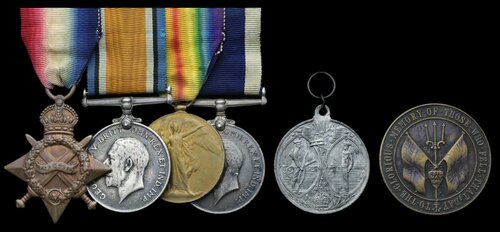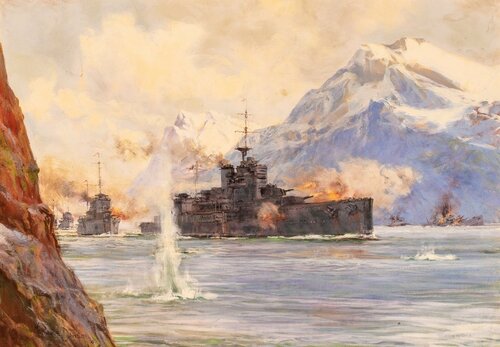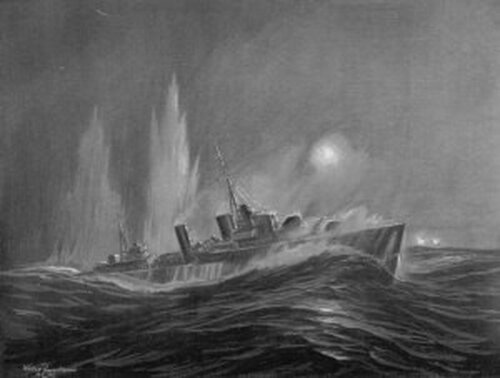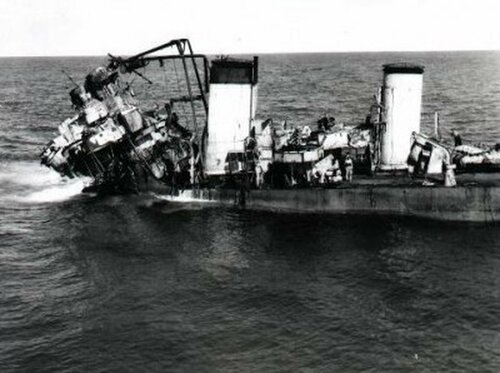Auction: 22001 - Orders, Decorations and Medals
Lot: 217
A Great War campaign group of four awarded to Able Seaman C. H. Knight, Royal Navy, a Jutland veteran who was killed in action in the destroyer H.M.S. Cossack in October 1941, when her bow was blown clean off by a torpedo
Having joined Cossack in February 1940, he may well have been present at the famous Altmark incident: more certain is the fact he was present at the 2nd battle of Narvik in April 1940 and in the Bismarck action in May 1941, prior to Cossack's loss at the year's end
1914-15 Star (J. 30883 C. H. Knight, Boy 1, R.N.); British War and Victory Medals (J. 30883 C. H. Knight, A.B., R.N.); Royal Navy L.S. & G.C., G.V.R., 3rd issue (J. 30883 C. H. Knight, A.B., H.M.S. Iron Duke), mounted as worn, together with Spink & Son Jutland commemorative, in bronze, polished, thus nearly very fine (5)
Cecil Herbert Knight was born in Southampton, Hampshire on 31 October 1898 and entered the Royal Navy as a Boy 2nd Class in May 1914. His subsequent wartime appointments included the battleship King George V (January 1916-June 1918), in which capacity he was present at the battle of Jutland.
Having then been awarded his L.S. & G.C. Medal in late 1937, he was pensioned ashore as an Able Seaman in the following year.
Recalled on the renewal of hostilities, Knight served in the cruiser Suffolk from September 1939 to February 1941, in which period she was badly damaged by enemy aircraft off Norway.
On 12 February 1940, following a few days ashore at the gunnery establishment Excellent, Knight joined the destroyer Cossack. Given the closeness of his appointment to her sailing for Norway at midnight on the 13th, it must remain a matter of speculation as to whether he was present at the Altmark incident, the brilliant action undertaken by Cossack's skipper, Captain Phillip Vian.
Close encounters (Part 1): the 2nd battle of Narvik
More certain is the fact that Knight would have seen action at the 2nd Battle of Narvik in April 1940, when Cossack - still under Vian's command - sustained major damage and numerous casualties.
The BBC's 'WW2 People's War' website takes up the story:
'The German destroyer Dieter van Roeder, which had suffered heavy damage, was alongside the jetty and saw Cossack when she first rounded the corner into the harbour. Both ships opened-up with all guns that would bear. Hits were scored by both, with the result that the Dieter van Roeder ceased fire. The Cossack was hit 7 times, including two 8-inch shells from the batteries onshore, and suffered a fractured steam pipe in her No. 2 boiler room, putting her steering gear out of action. She quickly drifted ashore at Hankins Point, where efforts were made to repair the damage to her engines and make her mess decks habitable again. Meanwhile Cossack was still firing and managed to silence a field gun that was firing from behind Narvik. Mortar and sniper fire was a constant hazard while she was attempting to patch up the damage inflicted. The Kimberley returned and tried to tow her off but was unable to move her.
A short while after the grounding, two young Norwegian cousins, Torsten and Lief Hansen from a small village over the mountain, Hard Fens, skied down to the Cossack bringing the welcome news that the Germans had retreated into the hills. This pair had rowed out to an abandoned German ship and removed her ensign, which they then presented to the Cossack. It now hangs in the Imperial War Museum, London. This pair had already helped the Pilot get the Navigator out of one of the British planes that had crashed the day before.
Temporary repairs were affected and with the high tide during the night, Cossack managed to free herself from the rocks. She could only go astern owing to the shell damage. This meant that progress was very slow. She limped to Skelfjord in the Lofoten Islands, where naval and Norwegian engineers, utilising old ship's plate that was lying nearby, worked on more permanent repairs to enable her to return to the U.K. It took practically three weeks to get the ship seaworthy and able to make her own way home. To thank the Norwegians for their assistance a children's party was given to all the local youngsters.
All the shipping in Narvik harbour was destroyed but sadly, during the battle, Cossack lost 9 men killed and 21 wounded. The dead were committed to the deep in Skelfjord in the traditional way.
Cossack was not the only ship to be patched up in the fjord; there were two cruisers and at least five others. Those who were there knew it as 'Cripple Creek'. All were able to return home in the end.
The Dieter van Roeder was abandoned when her ammunition ran out and she subsequently blew herself up.'
Close encounters (Part 2): Bismarck
Then, at the end of May 1941, Cossack participated in the Bismarck action, firing a spread of three torpedoes from 6,000 yards range. Said torpedoes were credited with 'denying Bismarck's crew with any sleep', but the same misfortune was likely afforded Cossack's crew: one of Bismarck's shells sheared off her antenna.
Later, by way of a souvenir of the occasion, Cossack rescued the pocket battleship's cat from floating wreckage. Not knowing its name - which was 'Sam' - Cossack's crew christened him 'Oscar'. According to The International Code of Signals, a square, diagonally red and yellow flag is called an Oscar and denotes a man overboard.
Journey's end: Loss of H.M.S. Cossack - 23 October 1941
In October 1941, and by now commanded by Captain E. L. Berthon, D.S.O., D.S.C., R.N., Cossack left Gibraltar, escorting a U.K. bound convoy.
On the night of the 23rd, when bringing up the rear of the convoy, she was hit forward of the bridge by a single torpedo from U-563. The resultant explosion blew off her bow and destroyed most of the forward section, killing Berthon and 159 officers and ratings. The survivors - some 30 of them wounded - were picked up by Legion and Carnation. The following day an attempt was made to tow Cossack to Gibraltar but in worsening weather she capsized on the 27 October.
Postscript
Aged 42, Knight left a widow, Ivy Francis Knight of Sholing, Hampshire.
He has no known grave and is commemorated on the Portsmouth Naval Memorial.
Subject to 20% VAT on Buyer’s Premium. For more information please view Terms and Conditions for Buyers.
Sold for
£320
Starting price
£200











